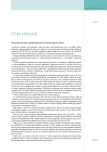Prognostic value of clinico-pathological factors in patiens with TaT1 bladder carcinoma
Authors:
Michael Pešl 1; Viktor Soukup 2; Marko Babjuk 3; Pavel Dundr 4; Otakar Čapoun 2; Zuzana Vaľová 2
Authors‘ workplace:
Urologické oddělení 1. LF UK a FNB, Praha
1; Urologická klinika 1. LF UK a VFN, Praha
2; Urologická klinika 2. LF UK a FNM, Praha
3; Patologický ústav 1. LF UK a VFN, Praha
4
Published in:
Ces Urol 2011; 15(4): 222-228
Category:
Original article
Overview
Aim:
The aim of our study is to assess significance of different prognostic factors in patients with TaT1 bladder tumour.
Methods:
There were 178 men and 68 women enrolled in the study, mean age 66.8 years (18–90 years). Patients were devided into groups according to tumour stage, grade, miltiplicity and concomitant carcinoma in situ (CIS). We focused on evaluation of recurrence and progression free survival.
Results:
Tumour T1 was found in 98 (33%) patients, Ta in 119 (48%) patients. Tumour G1 was found in 80 (33%), G2 in 105 (43%) and G3 in 42 (17%) patients. The tumour was multiple in 107 (43%) cases and solitary in 139 (57%) cases. Concomitant CIS was described in 6 (2%) patients. As a significant prognostic factor of recurrence free survival was found tumour grade (p = 0.0464) and multiplicity (p = 0.0459). Significant prognostic factor of progression was tumour stage (p = 0.001) and grade (p = 0.001).
Conclusion:
We conclude that assessment of clinicopathological prognostic factors in patients with TaT1 bladder tumours is useful for stratification of their follow-up and treatment. Our results corelate with other authors.
Key words:
prognostic factors, progression, recurrence, urinary bladder, urothelial carcinoma.
Sources
1. Národní onkologický registr. http://ksrzis.cz/registry-pro-odborniky/narodni-zdravotni-registry/nor/nor.html.
2. Babjuk M. Nádory močového měchýře. In: Dvořáček J, a kol. Urologie II, 1. vyd. Praha: ISV 1998; 965–1033.
3. Palou J. Patient risk profiles: Prognostic factors of recurrence and progression. Eur Urol Suppl 2006; 5 : 648–653.
4. Sylvester RJ, van der Meiden AP, Oosterlink W, et al. Predicting recurrence and progression in individual patients with stage TaT1 bladder cancer using EORTC rick tables: a combined analysis of 2596 patients from seven EORTC trials. Eur Urol 2006; 49 : 466–477.
5. Babjuk M, Oosterlink W, Sylvester RJ, Kaasinen E, Bohle A, Palau J. The European Association of Urology (EAU) Working group on Oncological urology. Guidelines on TaT1 (nonmuscle invasive) bladder cancer. EAU 2008.
6. Herr HW, Badalament RA, Amato DA, Laudone VP, fair WR, Whitmore Jr WF. Superficial bladder cancer treated with baccilus Calmette-Guérin: a multivariate analysis of factors affecting tumor progression. J Urol 1989; 141 : 22–29.
7. Millán Rodriguez F, Chéchile-Toniolo G, Salvador-Bayarri J, Palou J, Vincente-Rodriguez J. Multivariate analysis of the prognostic factors of primary superficial bladder cancer. J Urol 2000; 163 : 73–78.
8. Parmar MK, Freedman LS, Hargreave TB, Tlley DA. Prognostic factors for recurrence and followup policies in the treatment of superficial bladder cancer: report from the British Medical research Council Subgroup on Superficial Bladder Cancer (Urological Cancer Working party). J Urol 1989; 142 : 284–288.
Labels
Paediatric urologist Nephrology UrologyArticle was published in
Czech Urology

2011 Issue 4
Most read in this issue
- EUROPEAN BOARD OF UROLOGY
- Urachal carcinoma
-
Clean intermittent catheterization in the treatment of neurogenic dysfunctions of the lower urinary tract after spinal cord injury – comparison of the results of hydrophilic
Coated and standard PVC catheters - Strangulation injury of the penis – our experience with metallic materials
